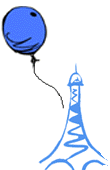| |
| SCBWI
France |
| |
| Meet
the Pros |
| |
| SCBWI France publishes interviews
both in the SCBWI France Expression newsletter
and on-line. These interviews offer an insider's
view of the international children’s
publishing market. |
| |
|
| Doug
Cushman |
Doug
Cushman has illustrated
over 80 books for children,
12 of which he wrote himself
Expression interviewed him in
November, in Paris where he
is currently living, developing
an expertise in French food
and wine and seeking inspiration.
|
|
 |
 |
|
1. SCBWI:
How did you come to work in children's books?
Doug Cushman:
Like many illustrators, two of my major influences
as an artist were comic strips and cartoons.
Walt Kelly, the writer and illustrator who
created Pogo, was an important influence as
he could draw AND write brilliantly. In a
way, comic strips are similar to picture books
in that drawing and text are perfectly designed
on a page to tell a story as simply as possible.
I think that's where my love for picture storytelling
was born.
I went to art school in New Haven, Connecticut,
which is the only formal training I've followed.
One of my instructors was the great book author,
illustrator and painter Leonard Everett Fisher.
After art school I apprenticed for a year
and a half with Mercer Mayer. During that
time I showed my portfolio to anyone who was
willing to look at it, going into New York
monthly to see editors and art directors.
I have supported myself as a writer/illustrator
ever since.
2.
SCBWI: Can tell us a bit about your working
method?
DC: My working
method is a little haphazard. I usually start
with a character in my sketchbook. As soon
as I get a germ of an idea I sketch it out,
drawing backgrounds, buildings, plants, supporting
characters, etc. I usually have no idea where
I'm headed. I might start jotting down snatches
of dialogue or words that create a certain
mood. I don't use outlines as I find them
too confining.
Early on I'll make a dummy, cutting
and stapling paper into a book, then laying
out my sketches and taping in the words. It's
a very physical process but then a picture
book is a very physical medium. Slowly, a
story will evolve. Every picture book has
its own pace, its own rhythm. What I'm trying
to do is find the rhythm. Once I have a solid
dummy I'll send it off to the editor. Then
the real work begins: editing, rewriting,
more dummies, more writing, more rewriting.
My working method with the finishes is pretty
straightforward. I trace each sketch from
the dummy onto watercolor paper using a light-box.
I ink each drawing, then paint. Watercolors
are my favorite medium, though at times I'll
add gouache, pastels and/or acrylics.
I vary the technique and look of my painting
to match the atmosphere of each book. I don't
want to force my style onto the story. Of
course, most of the stories I write and receive
from editors have a similar tone — humorous,
goofy, and at times, warm. But as an artist
I'm always looking to stretch myself. That's
one of the reasons I'm in Paris — I'm
hoping to absorb some the artistic energy
and atmosphere.
SCBWI: We
noticed that your email address comes courtesy
of one of your most famous characters, Aunt
Eater. Can you tell us a bit about her and
why it is that she is the only one visitors
to your site are encouraged to write to?
DC: Aunt
Eater is very close to my heart. She was my
first major character with Harper and there
are four books with her so far. She's really
the only one that has the time to write back
to students and others; Inspector Hopper's
writing is too small to read and last time
I heard, Seymour Sleuth was in Bali solving
a mystery, something about a Giant Mouse or
Rat in Sumatra (he doesn't write much to me
anyway.)
You can find out more about Doug and
his books, by writing to him care of Aunteater@aol.com,
or checking out Doug's website at www.doug-cushman.com
|
|
| Top
of page |
|
|
|
|
|
| |
|
|